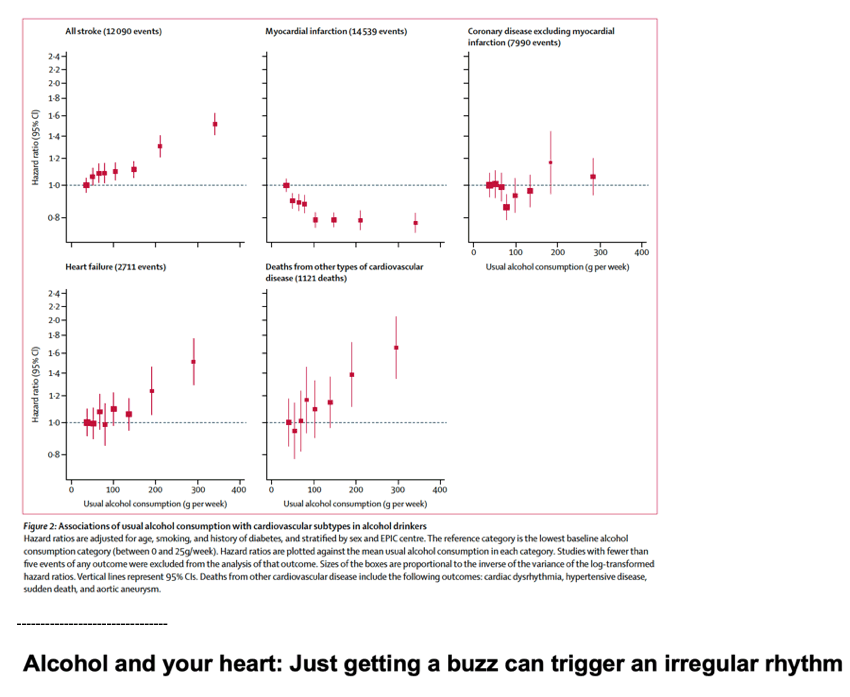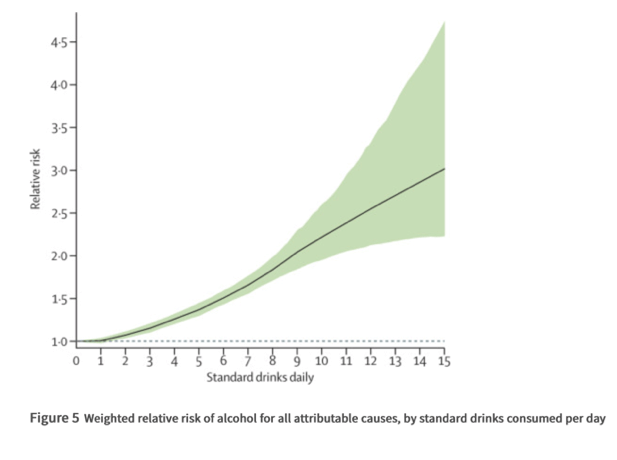| |
One Alcohol Drink A Day Increases Cancers Risk
|
| |
| |
"Even drinking one drink a day increases your risk of some cancers - including, if you're a woman, breast cancer - but also cancers of the digestive system, the mouth, stomach," said Tim Stockwell, a senior scientist with the Canadian Institute for Substance Use Research at the University of Victoria.
Women who drink are at a higher risk for breast cancer. Alcohol contributes about 6% of the overall risk, possibly because it raises certain dangerous hormones in the blood.
Drinking can also increase the chance you might develop bowel, liver, mouth and oral cancers.
"The risk increases with every drink you take."
https://www.cbc.ca/news/health/alcohol-warning-labels-cancer-1.6304816
Using data available only from method II (Table 4), an estimated 48% to 60% of alcohol-attributable cancer deaths occurred at average daily consumption levels of more than 40 grams of alcohol (i.e., ≥ 3 drinks per day). Consumption of from more than 20 grams to 40 grams (approximately 1.5 to < 3 drinks per day) was responsible for 14% to 17% of deaths, whereas consumption of 20 grams or less (≤ 1.5 drinks per day) accounted for 25% to 35% of alcohol-attributable cancer deaths (range among men = 17%-25%; range among women = 37%-51%; data stratified by sex not shown in tables). Although cancer risk increased with higher alcohol consumption levels, the greater percentage of total alcohol-related cancer deaths occurring among those consuming 20 grams or less per day, compared with those consuming more than 20 grams and up to 40 grams per day, stems from the larger number of persons who consumed alcohol at lower levels. https://ajph.aphapublications.org/doi/10.2105/AJPH.2012.301199
Light-moderate drinkers (HR 1.09, 95% CI 1.00-1.20) and heavy drinkers (HR 1.11, 95% CI 1.00-1.24) were at an increased risk of cancer overall (when combining men and women) when compared to never drinkers (Fig 4). When average lifetime alcohol was assessed as a continuous variable, each additional drink per day was associated with a small increase in total risk of cancer in men (HR 1.01, 95% CI 1.00-1.02). No major differences were observed by age, smoking status, BMI, or randomisation group (S3 Fig), but differences by type of alcohol were observed (S4 Fig). Light lifetime alcohol consumption was associated with reduced overall and cardiovascular-related mortality compared to never drinking.Higher average lifetime alcohol consumption was also linearly associated with increased cancer-related mortality and cancer incidence. Combining the risk of cancer and death into a single analysis attenuated the modest reduction in risk observed for light drinkers, suggesting only a small benefit in risk for light drinkers compared to never drinkers. The United Kingdom recently lowered their guidelines for men to recommend less than 14 units (about 1 drink) per week, several alcohol-free days per week, and limiting the total amount of alcohol in one session [23]. https://journals.plos.org/plosmedicine/article?id=10.1371/journal.pmed.1002585
Alcohol consumption was roughly linearly associated with a higher risk of stroke (HR per 100 g per week higher consumption 1⋅14, 95% CI, 1⋅10-1⋅17), coronary disease excluding myocardial infarction (1⋅06, 1⋅00-1⋅11), heart failure (1⋅09, 1⋅03-1⋅15), fatal hypertensive disease (1⋅24, 1⋅15-1⋅33); and fatal aortic aneurysm (1⋅15, 1⋅03-1⋅28). By contrast, increased alcohol consumption was log-linearly associated with a lower risk of myocardial infarction (HR 0⋅94, 0⋅91-0⋅97). In comparison to those who reported drinking >0-≤100 g per week, those who reported drinking >100-≤200 g per week, >200-≤350 g per week, or >350 g per week had lower life expectancy at age 40 years of approximately 6 months, 1-2 years, or 4-5 years, respectively. In current drinkers of alcohol in high-income countries, the threshold for lowest risk of all-cause mortality was about 100 g/week. For cardiovascular disease subtypes other than myocardial infarction, there were no clear risk thresholds below which lower alcohol consumption stopped being associated with lower disease risk. These data support limits for alcohol consumption that are lower than those recommended in most current guidelines. https://www.thelancet.com/journals/lancet/article/PIIS0140-6736(18)30134-X/fulltext#seccestitle130
--------------------------------

https://www.cnn.com/2021/01/27/health/alcohol-heartion-wellness/index.html
Women who drink are at a higher risk for breast cancer. Alcohol contributes about 6% of the overall risk, possibly because it raises certain dangerous hormones in the blood.
Drinking can also increase the chance you might develop bowel, liver, mouth and oral cancers.
A 2018 study co-authored by University of Cambridge epidemiologist Steven Bell found that while drinking was beneficial in lowering the risk for heart attack, even one drink a day shortened life expectancy. Reducing alcohol use added one to two years to life expectancy at age 40, Bell said in a prior interview.
According to Bell, the "take-home message" from his study is that "people shouldn't drink under the belief that it will lower their risk of disease."
"And those of us who opt to drink should minimize our intake if we wish to prolong our life and well-being," Bell said.
In 2016, alcohol use led to 2⋅8 million deaths and was the leading risk factor for premature death and disability among people aged 15-49 years, with nearly 9% of all attributable DALYs for men and more than 2% for women. Our findings indicate that alcohol use was associated with far more health loss for males than for females, with the attributable burden for men around three times higher than that for women in 2016. By evaluating all associated relative risks for alcohol use, we found that consuming zero standard drinks daily minimises the overall risk to health.
The level of alcohol consumption that minimised harm across health outcomes was zero (95% UI 0⋅0-0⋅8) standard drinks per week.
https://www.thelancet.com/journals/lancet/article/PIIS0140-6736(18)31310-2/fulltext
Additionally, some research suggests that low levels of alcohol consumption can have a protective effect on ischaemic heart disease, diabetes, and several other outcomes.4, 5, 6
In estimating the weighted relative risk curve, we found that consuming zero (95% UI 0⋅0-0⋅8) standard drinks daily minimised the overall risk of all health loss (figure 5). The risk rose monotonically with increasing amounts of daily drinking. This weighted relative risk curve took into account the protective effects of alcohol use associated with ischaemic heart disease and diabetes in females. However, these protective effects were offset by the risks associated with cancers, which increased monotonically with consumption. In a sensitivity analysis, where we explored how the weighted relative risk curve changed on the basis of the choice of weights for various health outcomes, the curve changed significantly only in settings where diabetes and ischaemic heart disease comprised more than 60% of total deaths in a population.
Beyond 50 years of age, the causes of total attributable burden became more complex by SDI quintile. For populations aged 50 years and older, cancers accounted for a large proportion of total alcohol-attributable deaths in 2016, constituting 27⋅1% (95% UI 21⋅2-33⋅3) of total alcohol-attributable female deaths and 18⋅9% (15⋅3-22⋅6) of alcohol-attributable male deaths. In high SDI countries, cancers were the predominant source of attributable burden among both sexes. In low SDI countries, tuberculosis was the primary cause of burden for both sexes, followed by cirrhosis and other chronic liver diseases. The profile of attributable burden in high-to-middle SDI and middle SDI countries for females and males was largely composed of ischaemic stroke and haemorrhagic stroke, followed by liver cancer for females. In all SDI quintiles, haemorrhagic stroke and hypertensive heart disease were the largest sources of burden for females aged 80 years and older. For men in this age group, the composition of the burden was similar to that of males aged 50 years or older.
Health risks associated with alcohol consumption
Figure 4 shows the relative risk curves for selected health outcomes, separately for females and males. Estimated relative risk curves for each health outcome are presented in appendix 2 (pp 52-140). With this analysis, we only found statistically significant evidence for the J-shaped curve for ischaemic heart disease; non-significant J-shaped curves were observed for diabetes and ischaemic stroke. For ischaemic heart disease, we found a minimum relative risk of 0⋅86 (0⋅80-0⋅96) for men and 0⋅82 (0⋅72-0⋅95) for women, occurring at 0⋅83 standard drinks daily for men and 0⋅92 standard drinks daily for women. We found no significant difference in relative risk curves for ischaemic heart disease or diabetes when estimating the curves by age. For all other outcomes, including all cancers, we found that relative risk monotonically increased with alcohol consumption (appendix 2, pp 57-146).

|
|
| |
| |
|
|
|